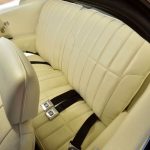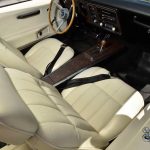With the outstanding sales success of the 1964 1/2 Ford Mustang, Chevrolet realized they needed a more direct competitor than the Corvair. The Chevy Camaro bowed in September of 1966, with the Pontiac Firebird following five months later. The Firebird was somewhat different in appearance to the Camaro, although the front fenders, rear fenders, and door skins with the same. The Firebird did get the trademark Pontiac beaked split grille and hood, and taillights similar to those of the Pontiac GTO.
The new Pontiac Firebird could be had with any of a variety of six cylinders or V8s. The standard-issue powerplant was the 230 cubic-inch inline six with a single-barrel carb, delivering an economical 165 horsepower. The Firebird Sprint came with a more potent version of the inline six fed by a four-barrel carb and producing 215 horsepower. Available V8s included two versions of the Pontiac 326, one fed by a two-barrel carb, the other a four-barrel, and making 250 and 285 horsepower respectively. The heavy hitter in the Firebird engine lineup was a 325-horsepower 400 cube V8 shared with the GTO. The six-cylinder engines could be paired with either the two-speed Powerglide automatic, or a three- or four-speed manual. The V8 offerings could be had with two- or three-speed automatics, or heavy-duty three- or four-speed manuals. The Firebird was priced $200 higher than the Camaro, and the Camaro outsold the Firebird by almost two-to-one.
The Pontiac Firebird got more power for the 1968 model year, with six-cylinder offerings growing in displacement to 250 cubic inches, with the base engine producing 175 horsepower. Despite the increase in size, the six in the Firebird Sprint soldiered on with 215 horses under the hood. The 326 cubic-inch V8s grew to 350 cubes (actually 354, but that is a conversation for another time), with power for the two-barrel engine increasing to 365 horsepower. The High Output 350 made 320 horses, and the 400 cube V8 gained five more ponies for a total of 330.
For the 1969 model year, the Pontiac Firebird received a number of the changes its F-Body corporate cousin, the Chevy Camaro, received. The front fender arches were flattened, giving it a more aggressive appearance. Door skins and rear quarter panels were redesigned, as were the roofline and a lower beltline. The gas filler was relocated behind the rear license plate, and the grille, front bumper, and parking lights were all new. Firebirds could be had with either inline six-cylinder engines or V8s. In early March 1969, the Trans Am Appearance and Performance Package debuted, with 689 coupes and eight convertibles rolling off the assembly line.
Our feature 1969 Pontiac Firebird coupe has been the subject of a rotisserie restoration. It is finished in Antique Gold over a Parchment vinyl bucket seat interior. It is powered by its original 400 cubic-inch V8 producing 330 horsepower. A Turbo 400 Hydramatic three-speed automatic transmission backs the 400. The Firebird is equipped with power steering, four-wheel power disc brakes, dual exhaust, Deluxe interior with center console, AM-FM radio, Rally gauges with tachometer, wood steering wheel, and powder-coated frame and suspension components. The Firebird rolls on fifteen-inch PMD Rally wheels shod in raised white-letter BFGoodrich Radial T/A rubber. Included in the sale are Pontiac Historical Society documents.
This restored 1969 Pontiac Firebird coupe will cross the Mecum Auctions block at their Las Vegas, Nevada event Saturday, October 19th.




































Comment
William Bonney, I love that car.